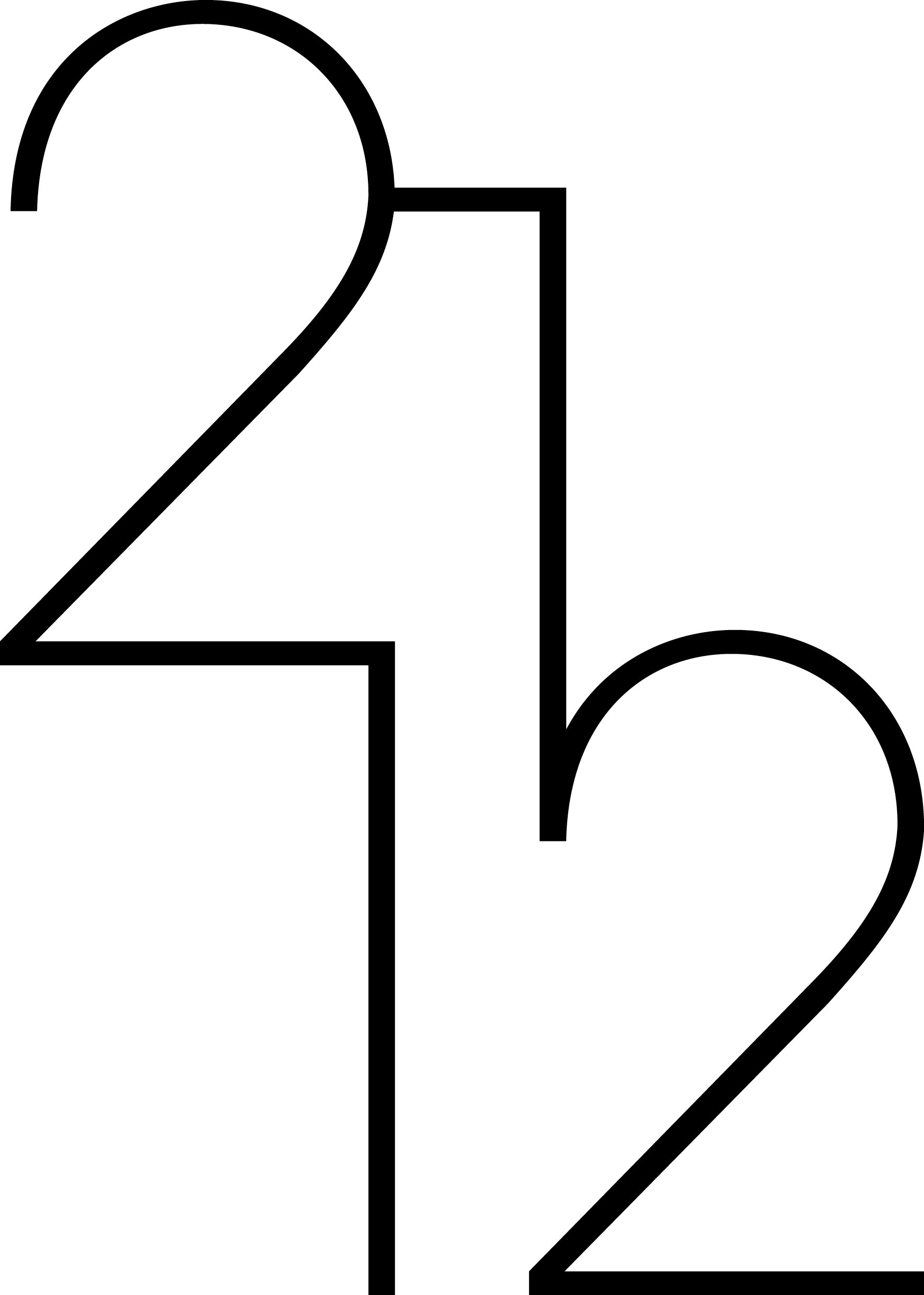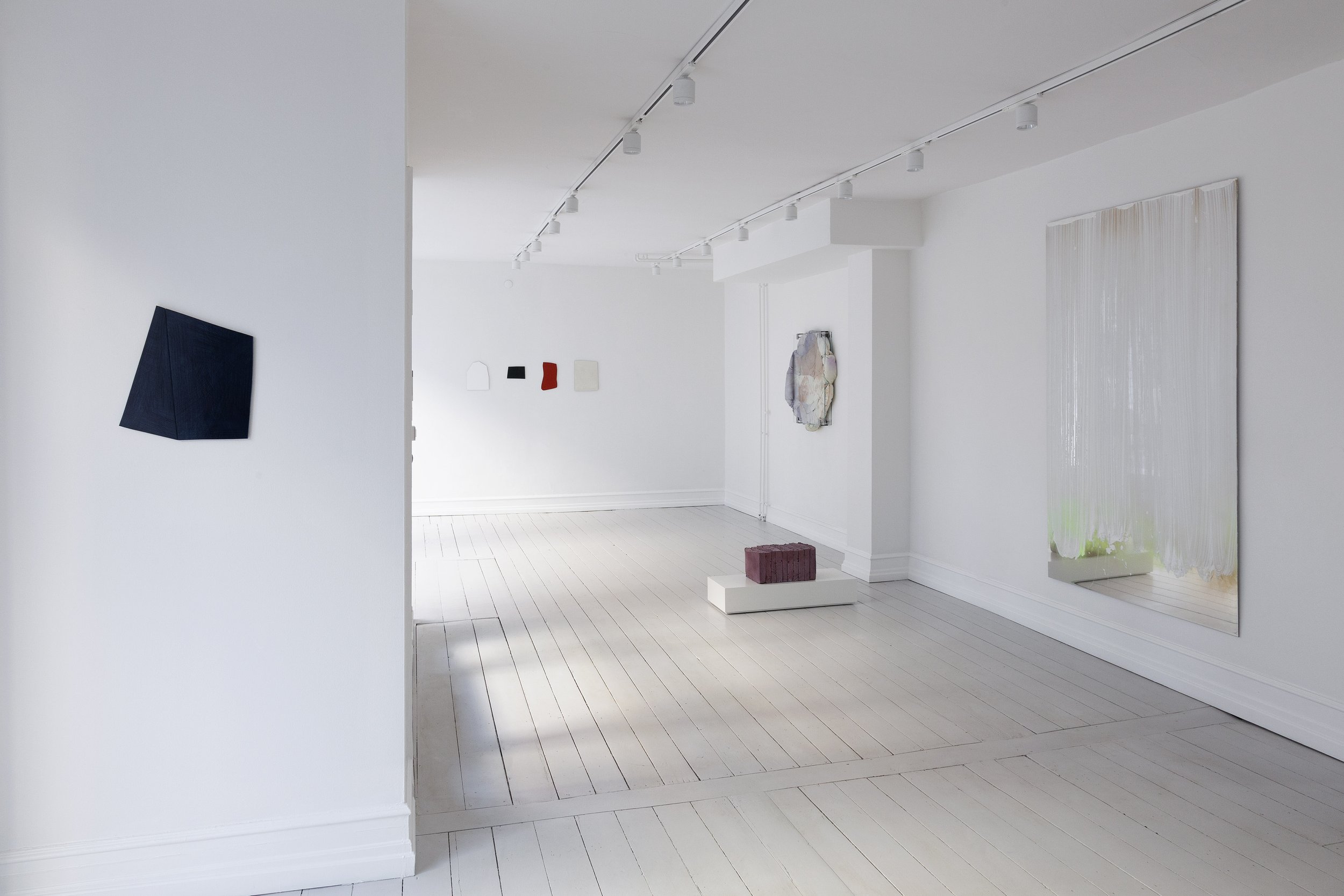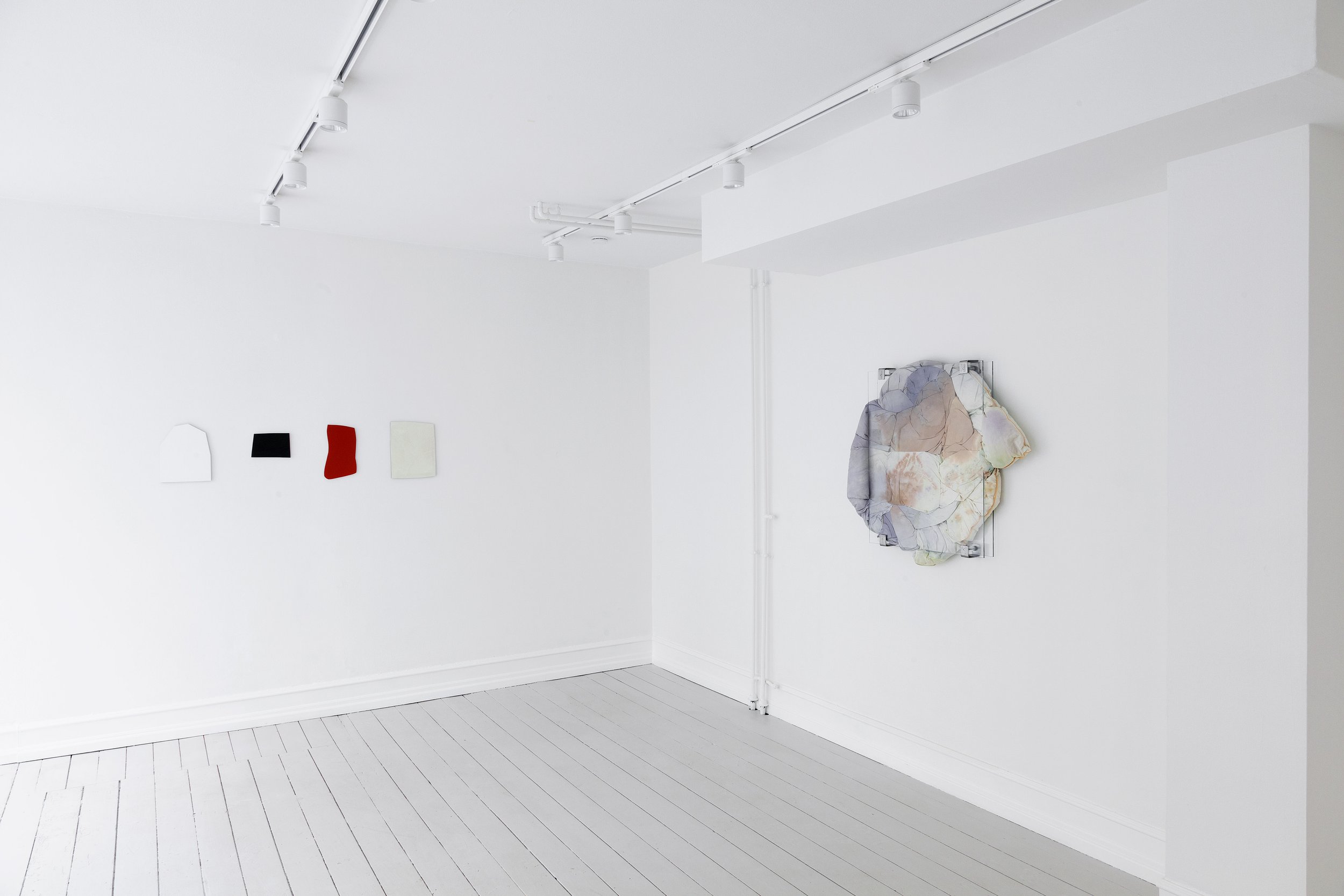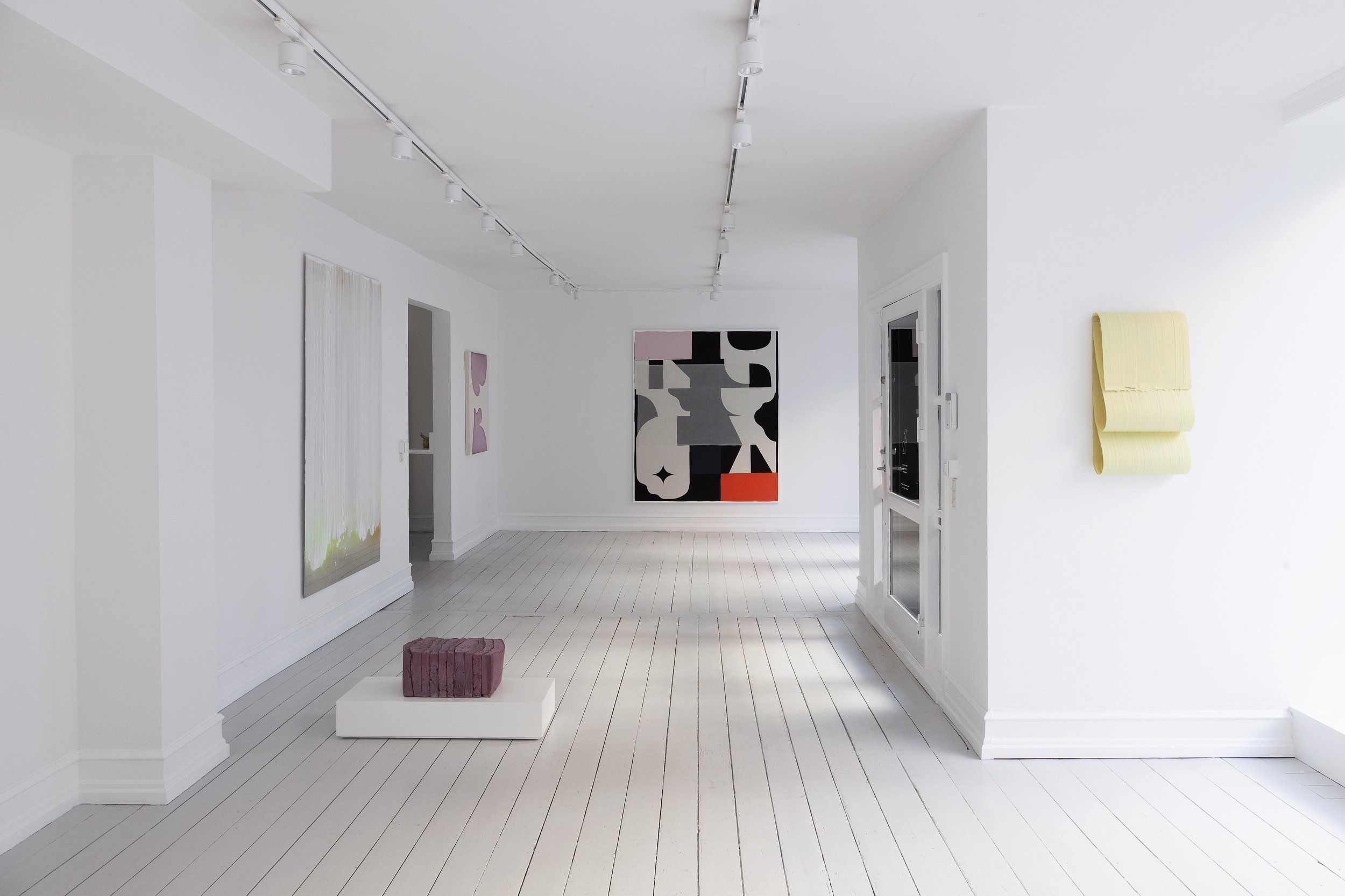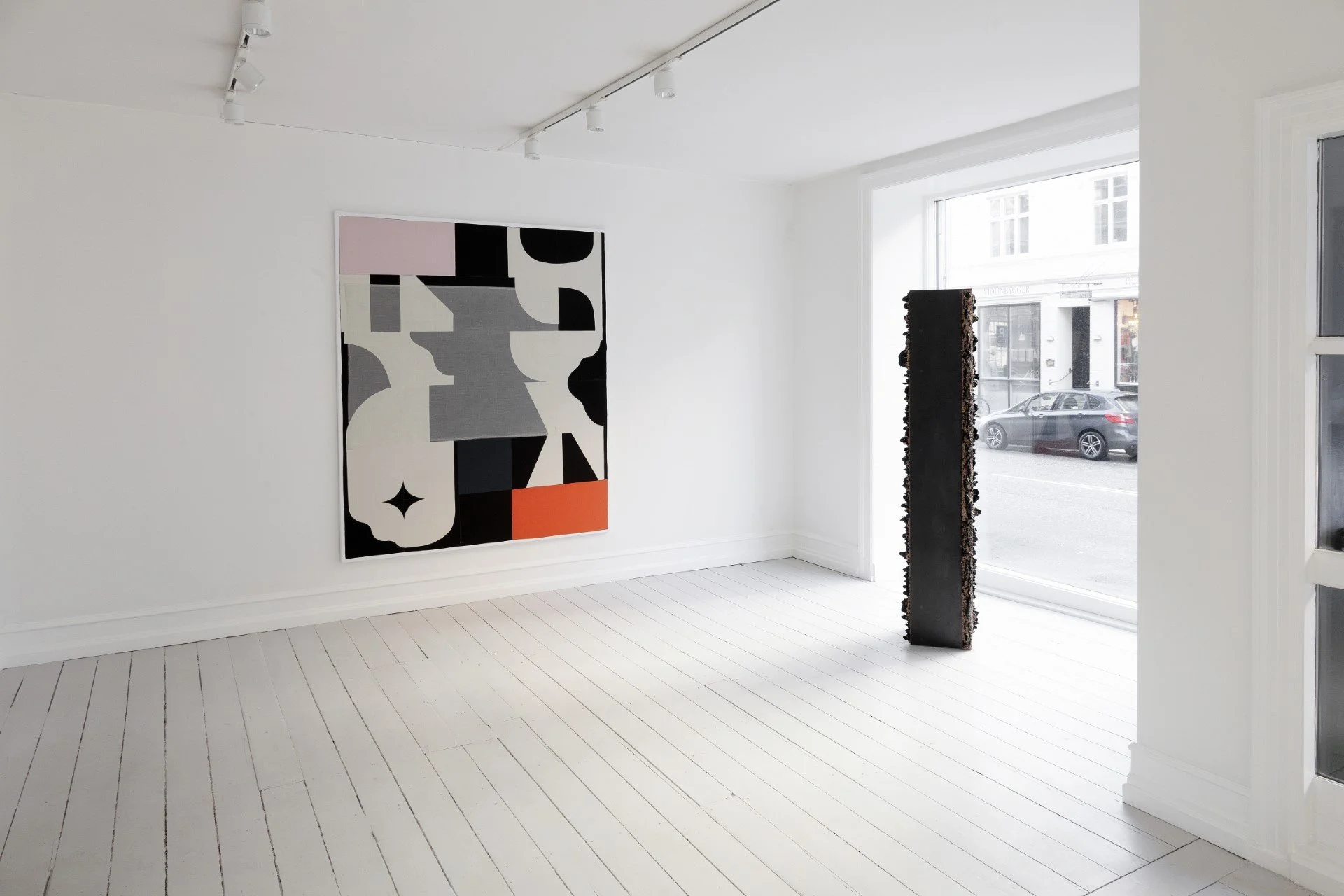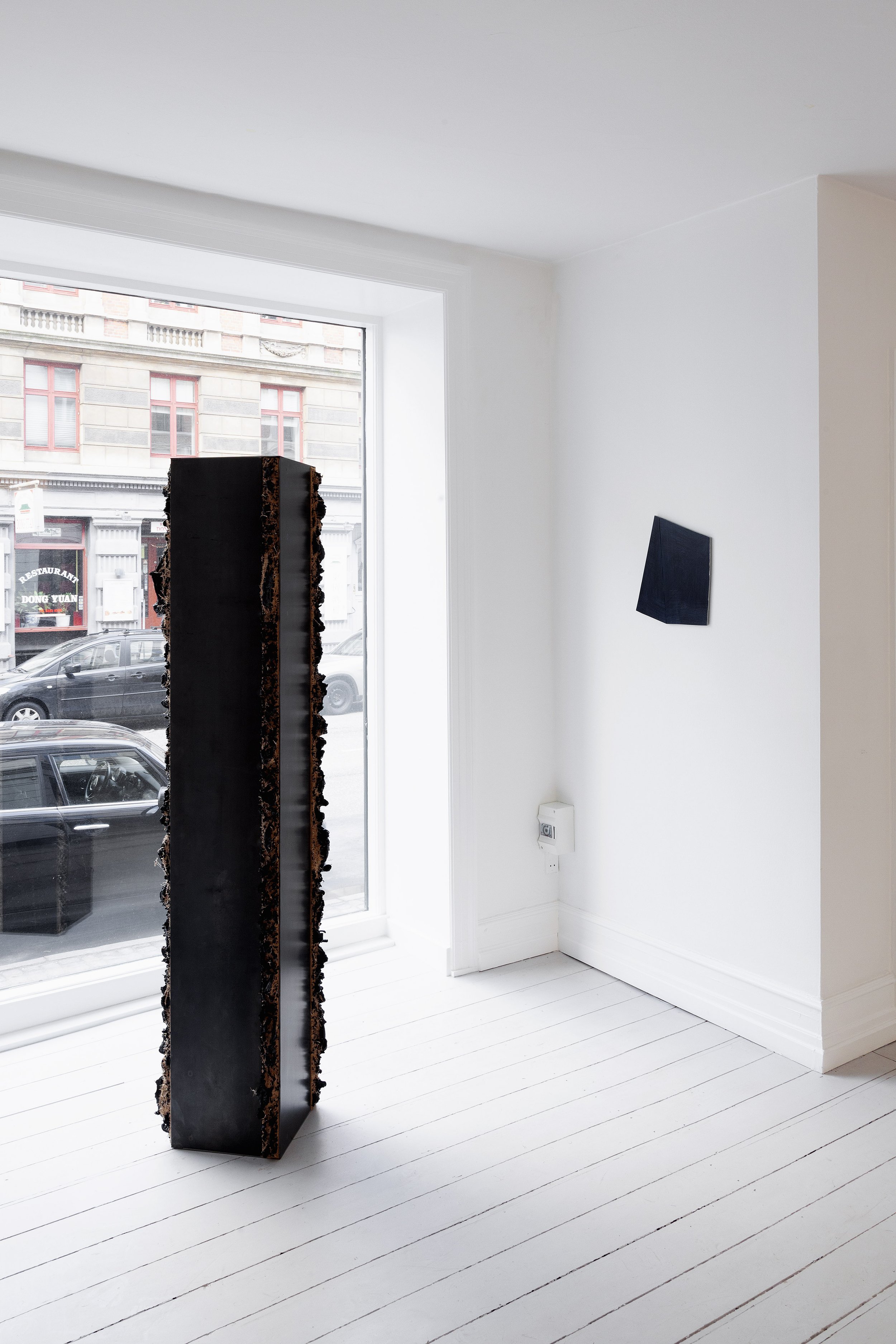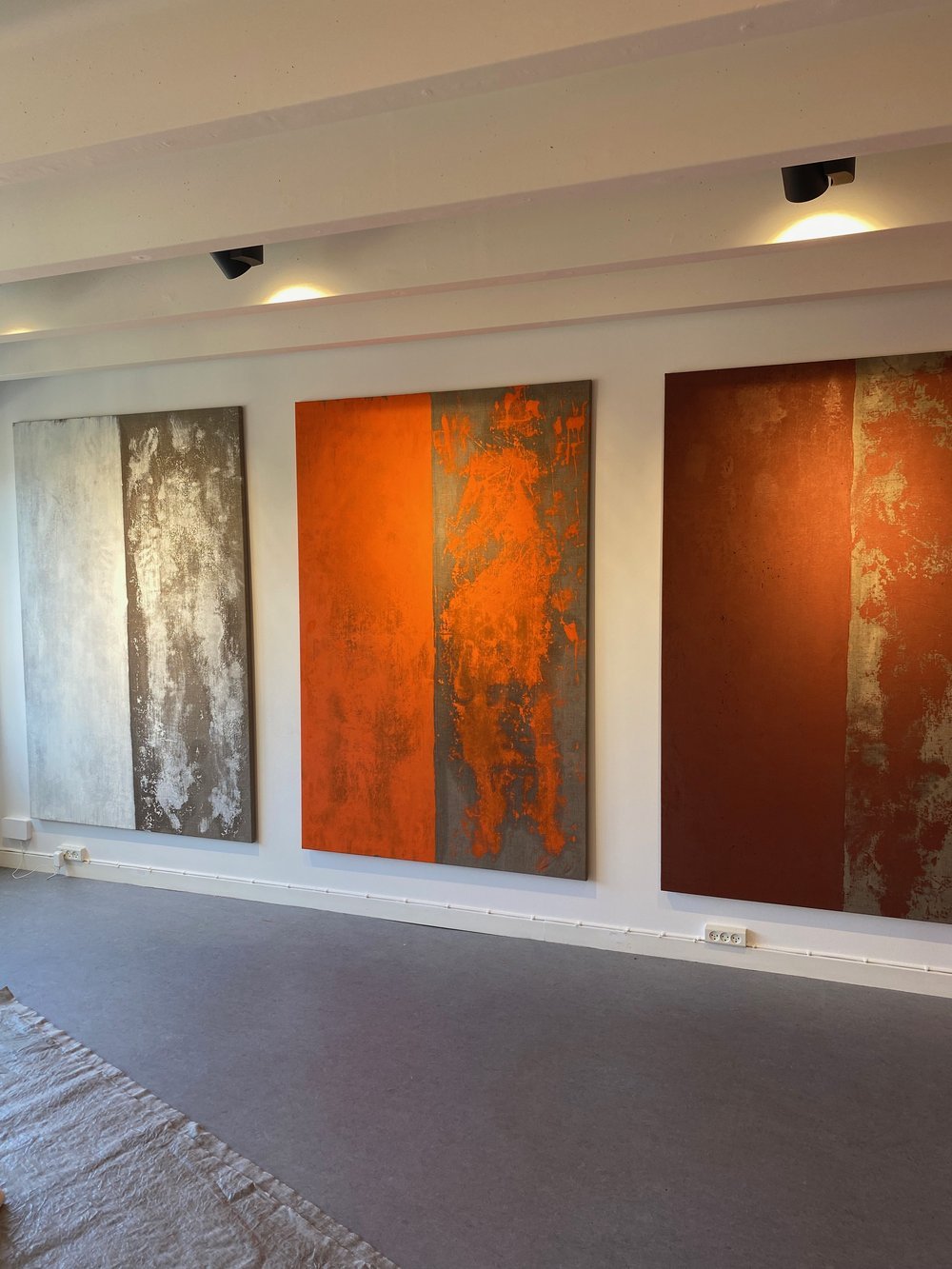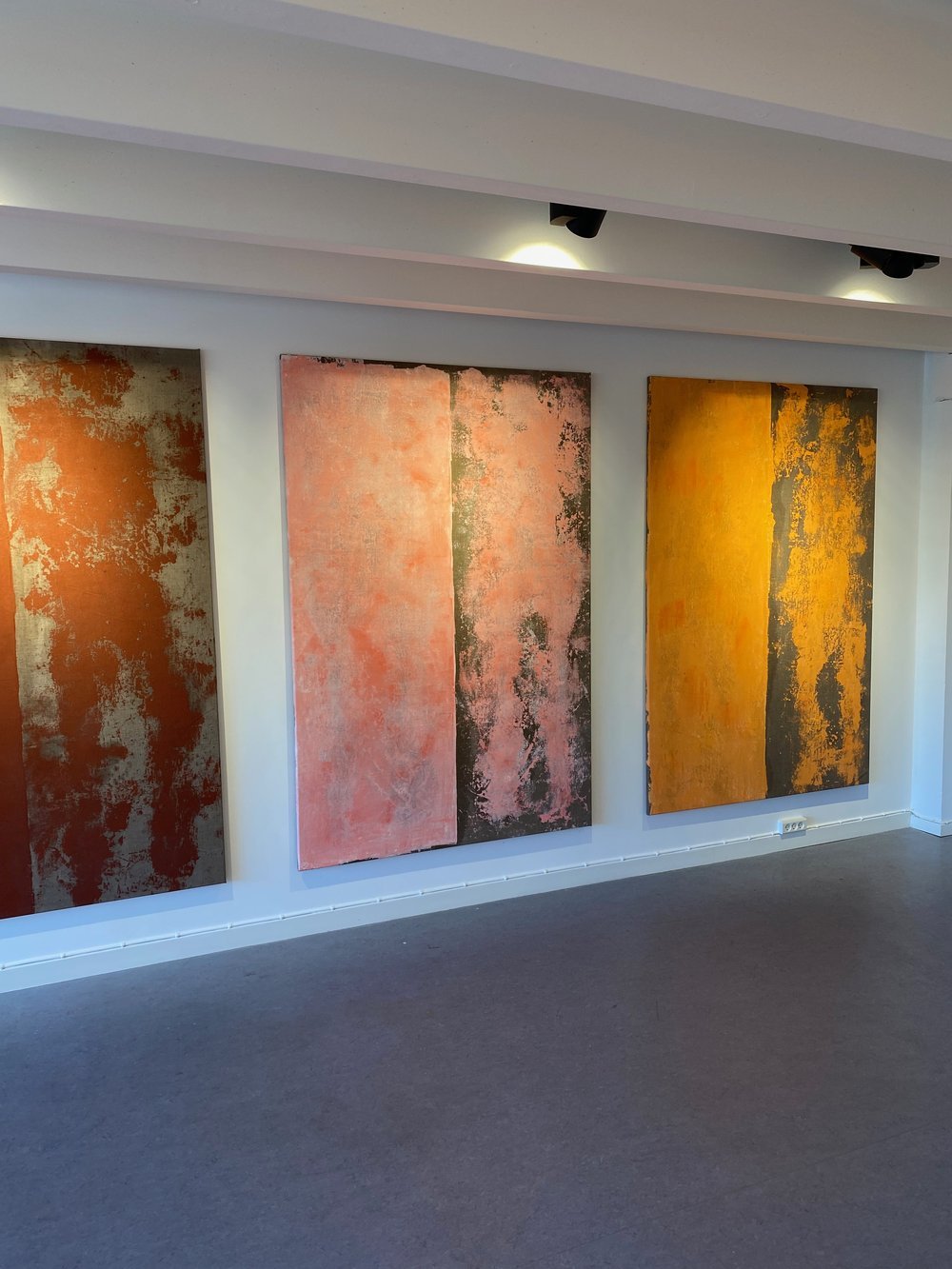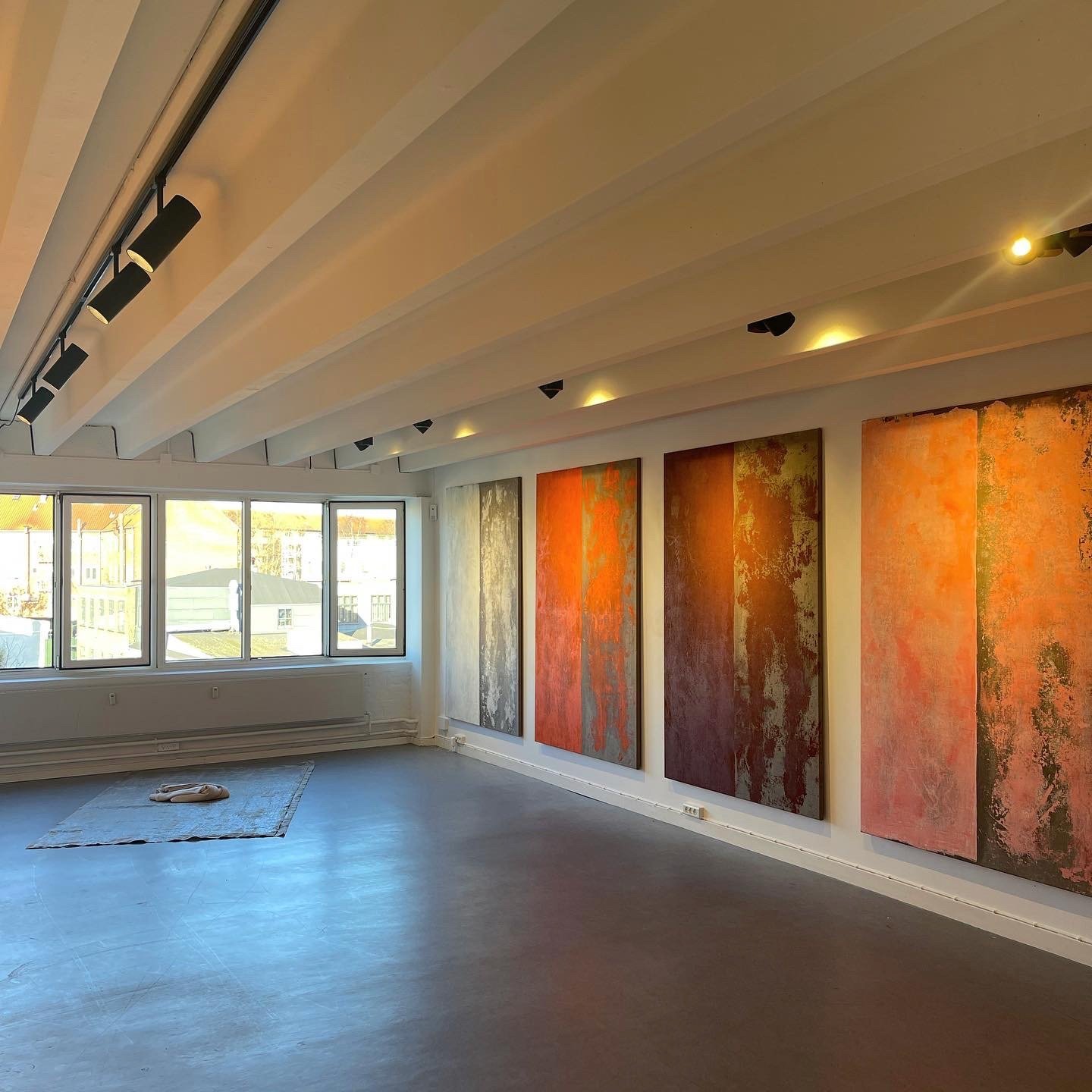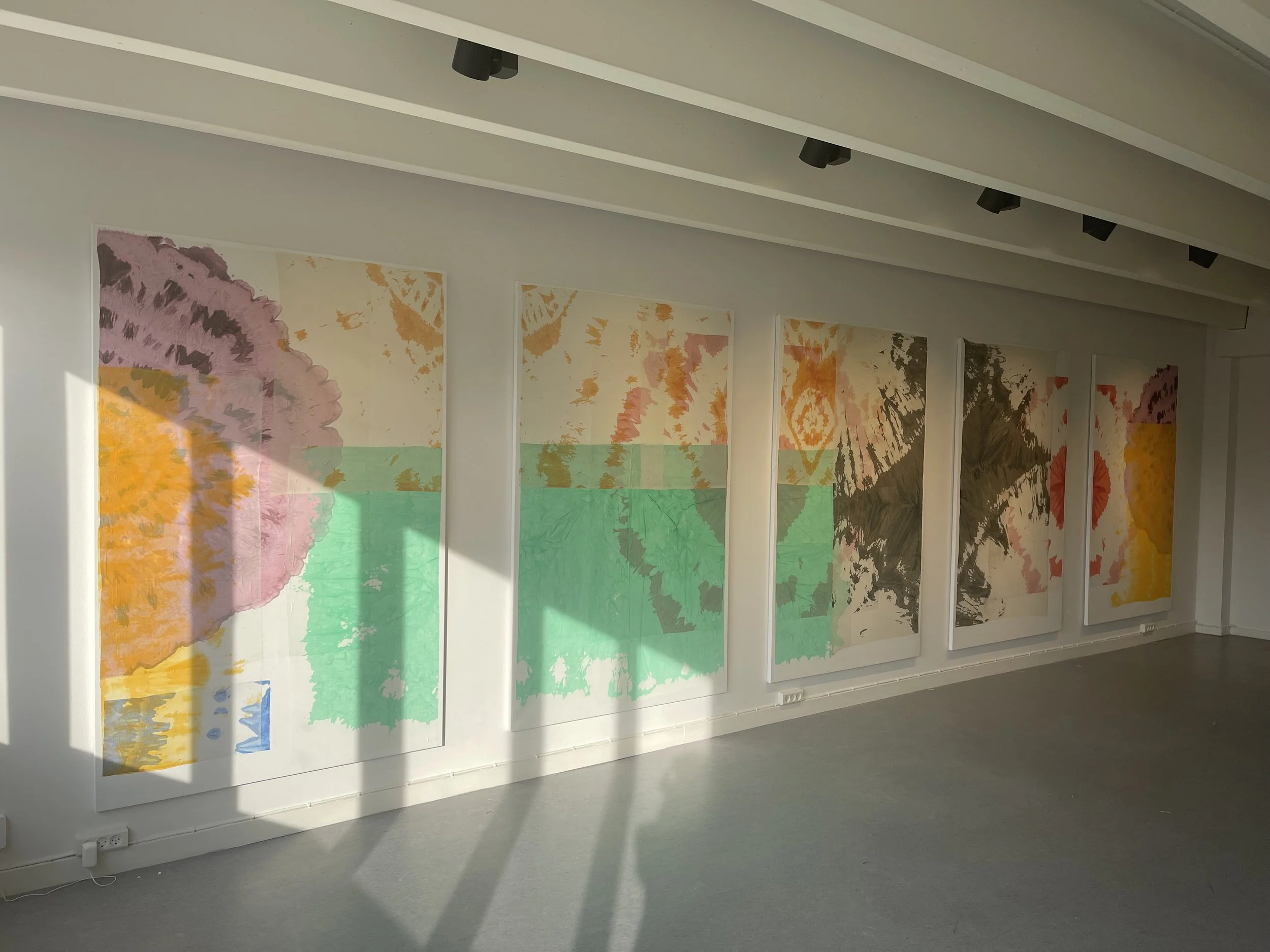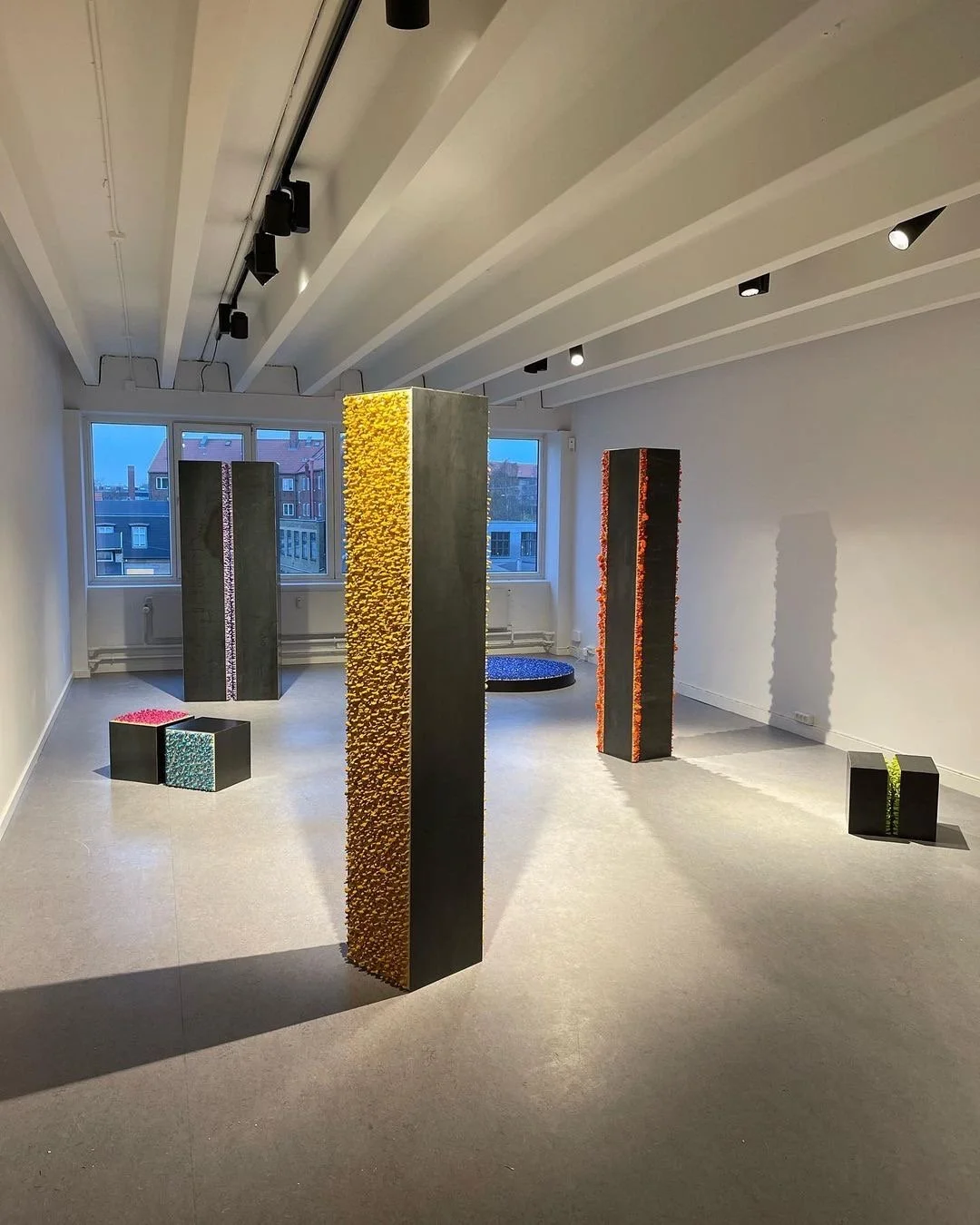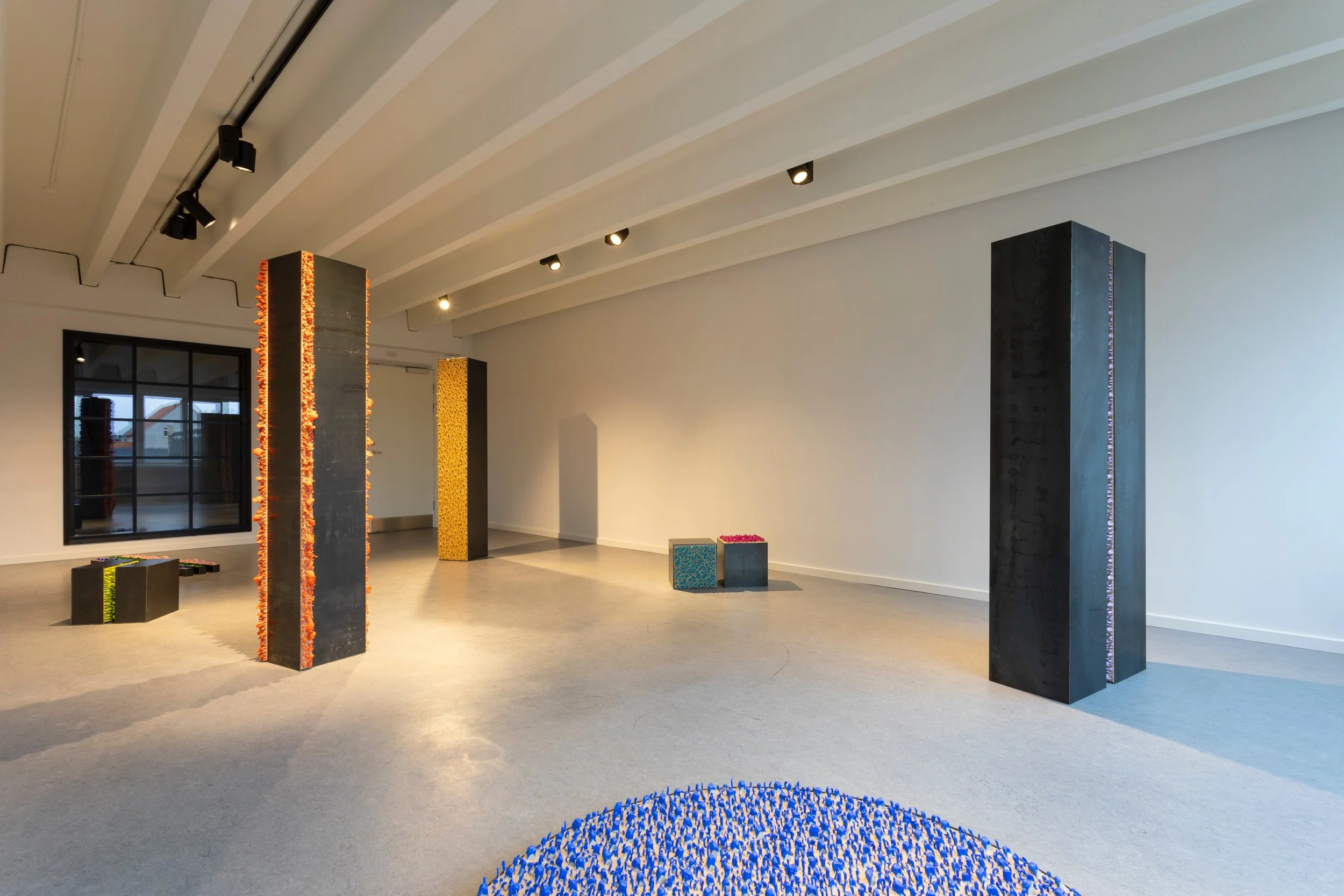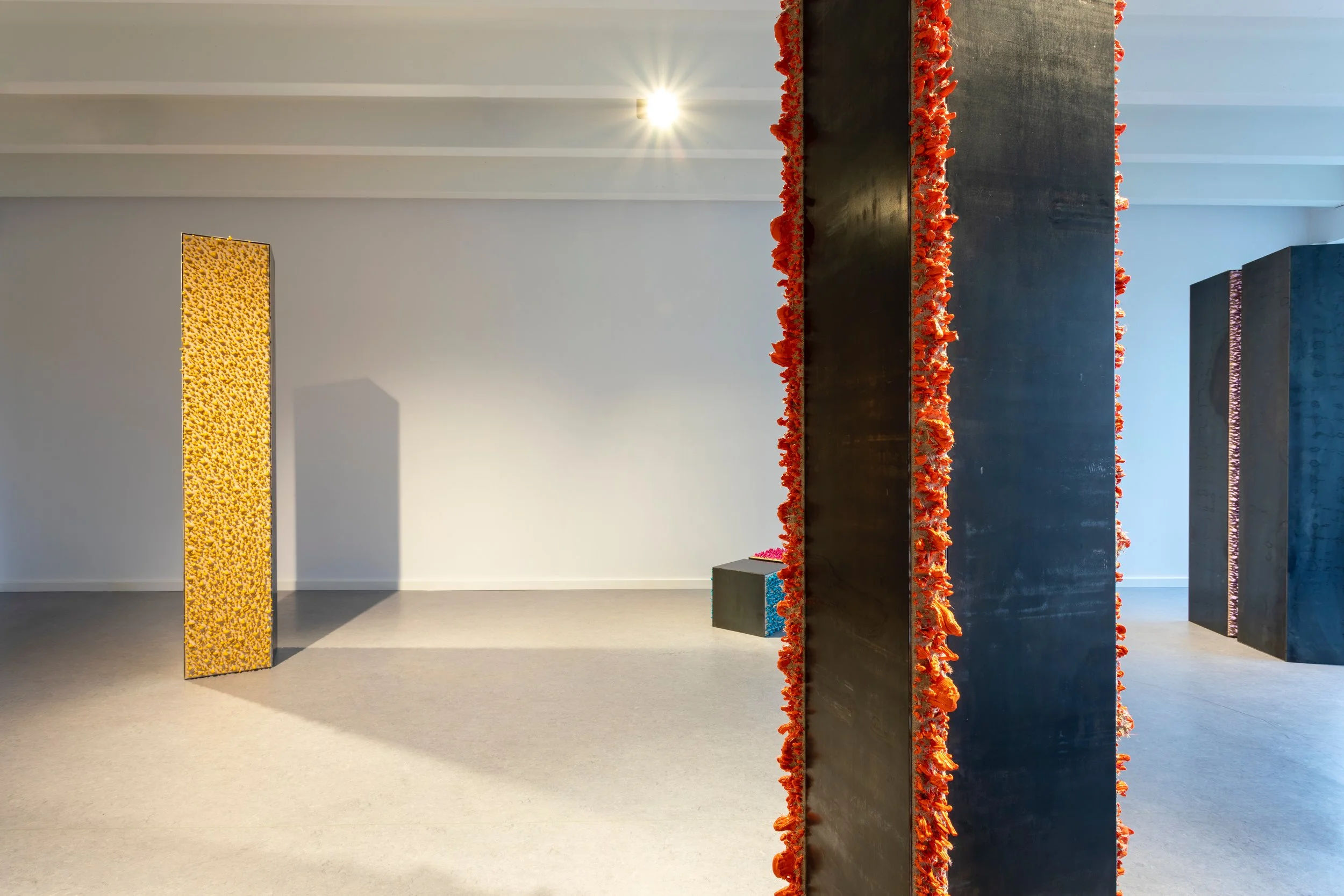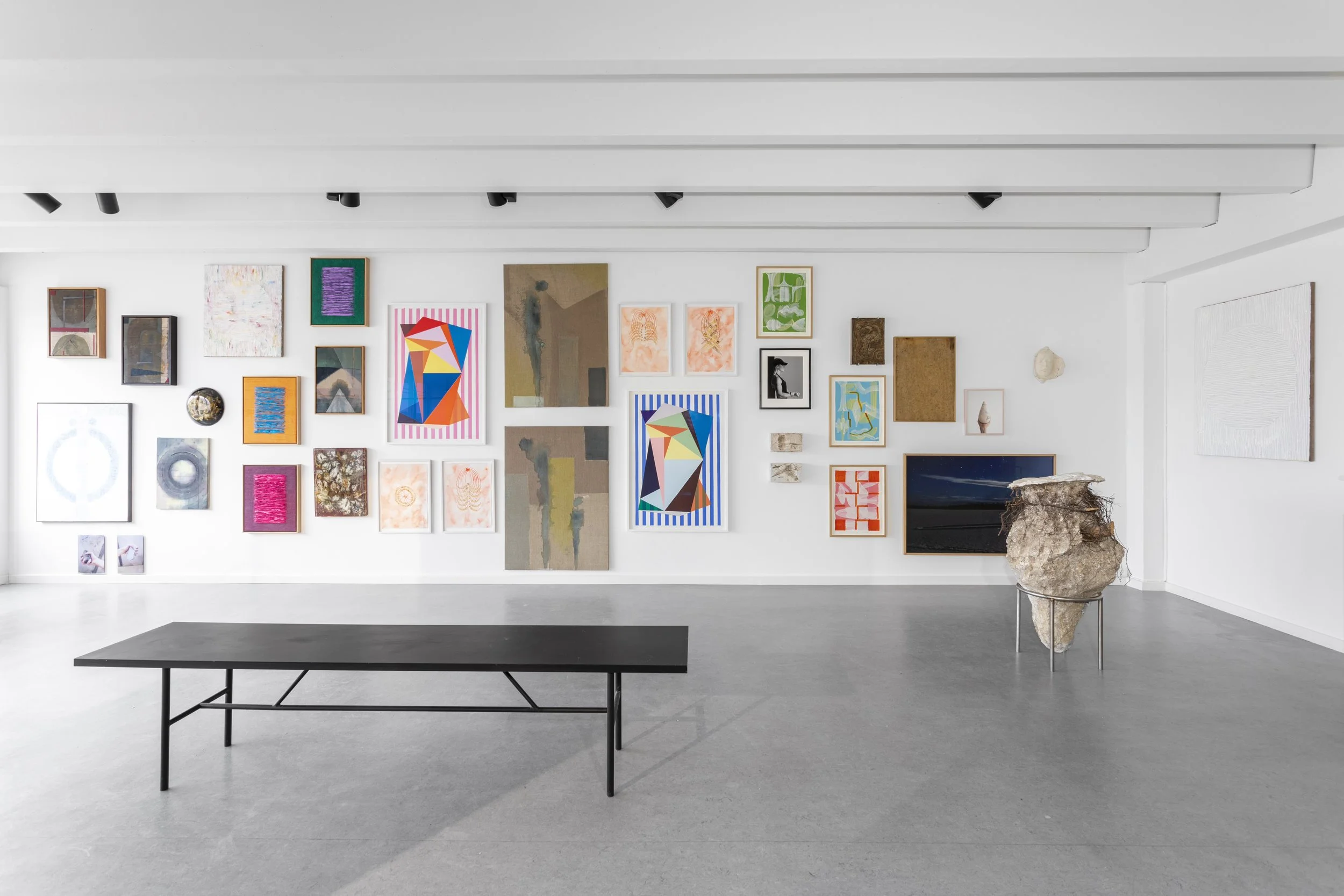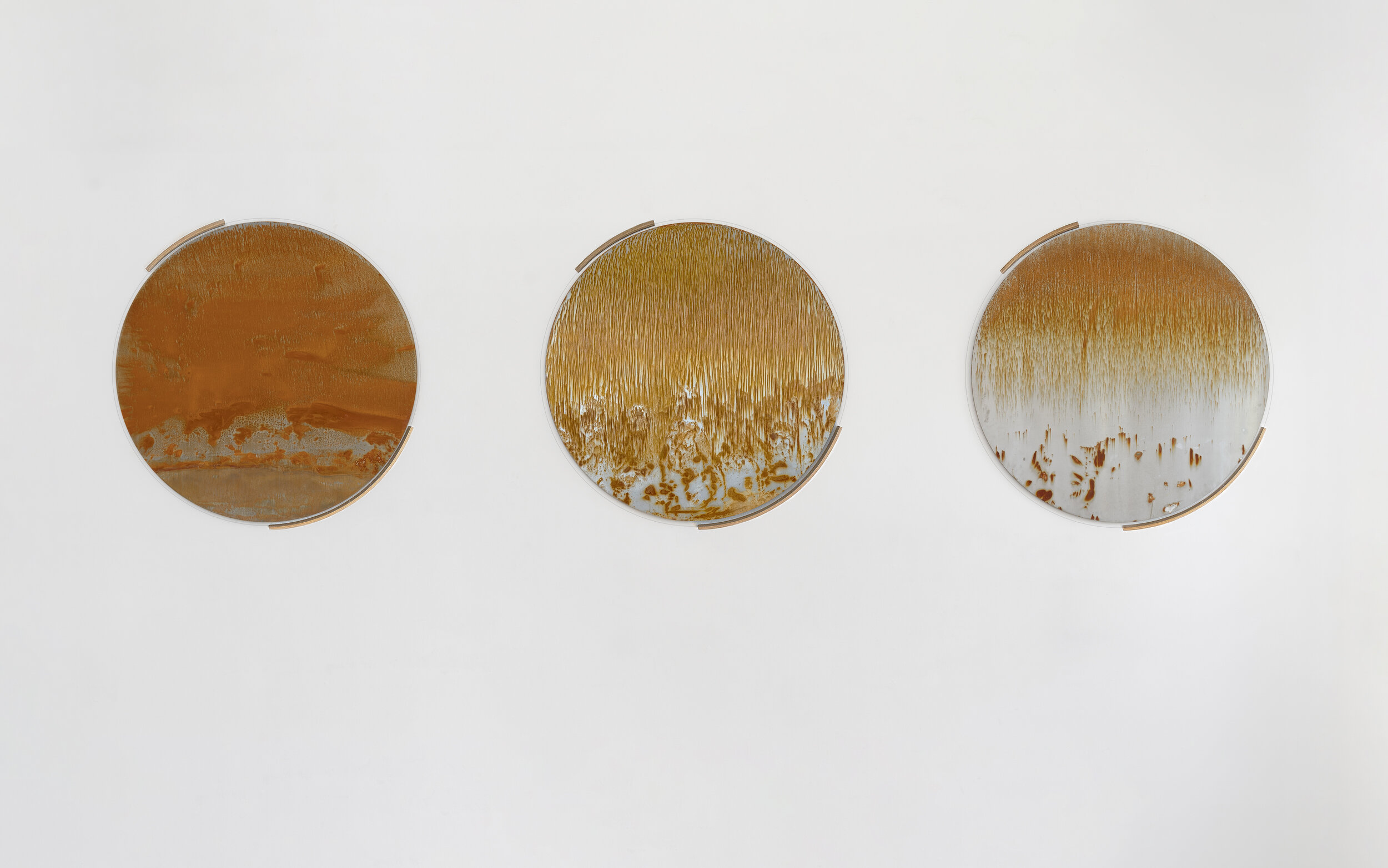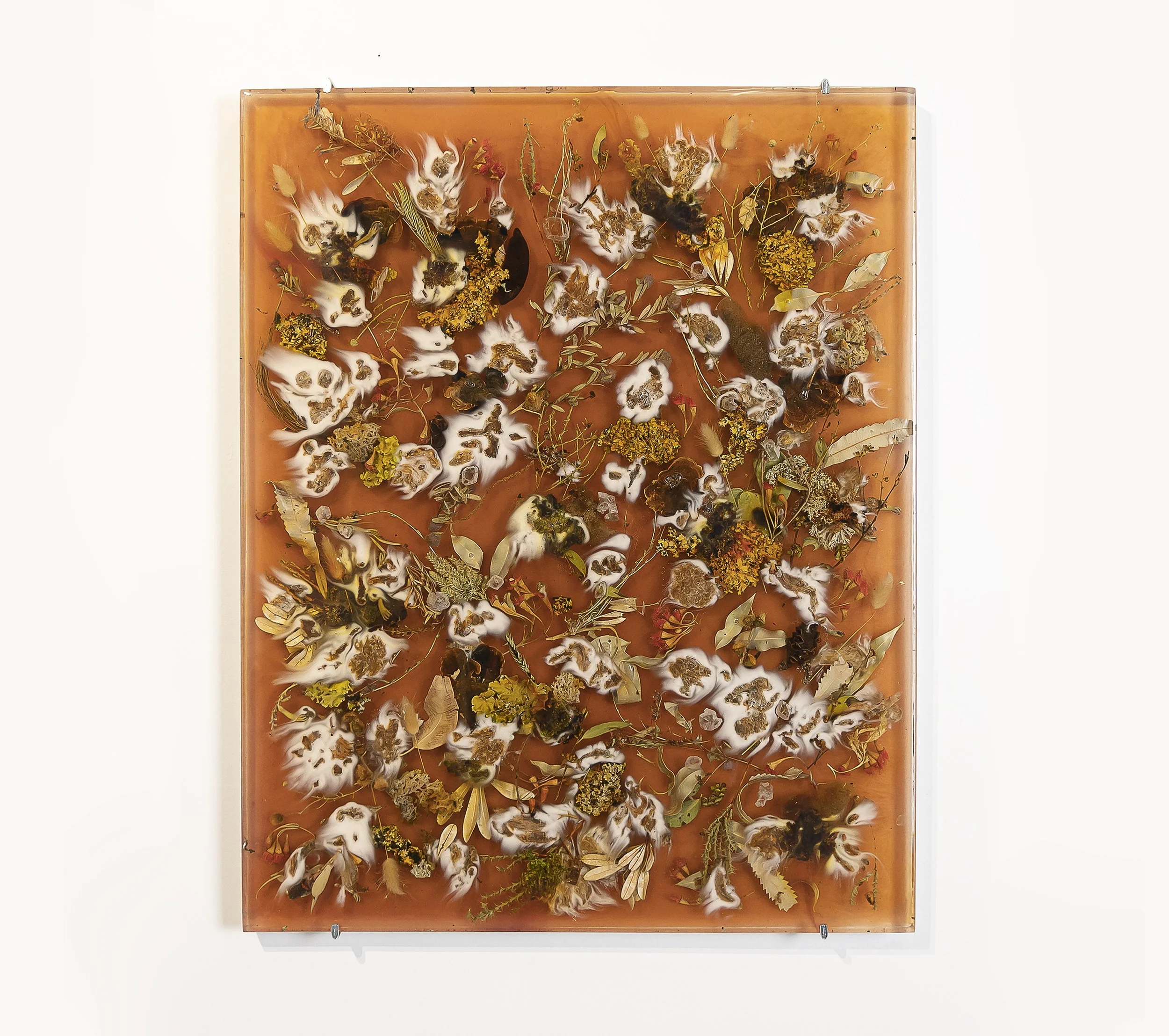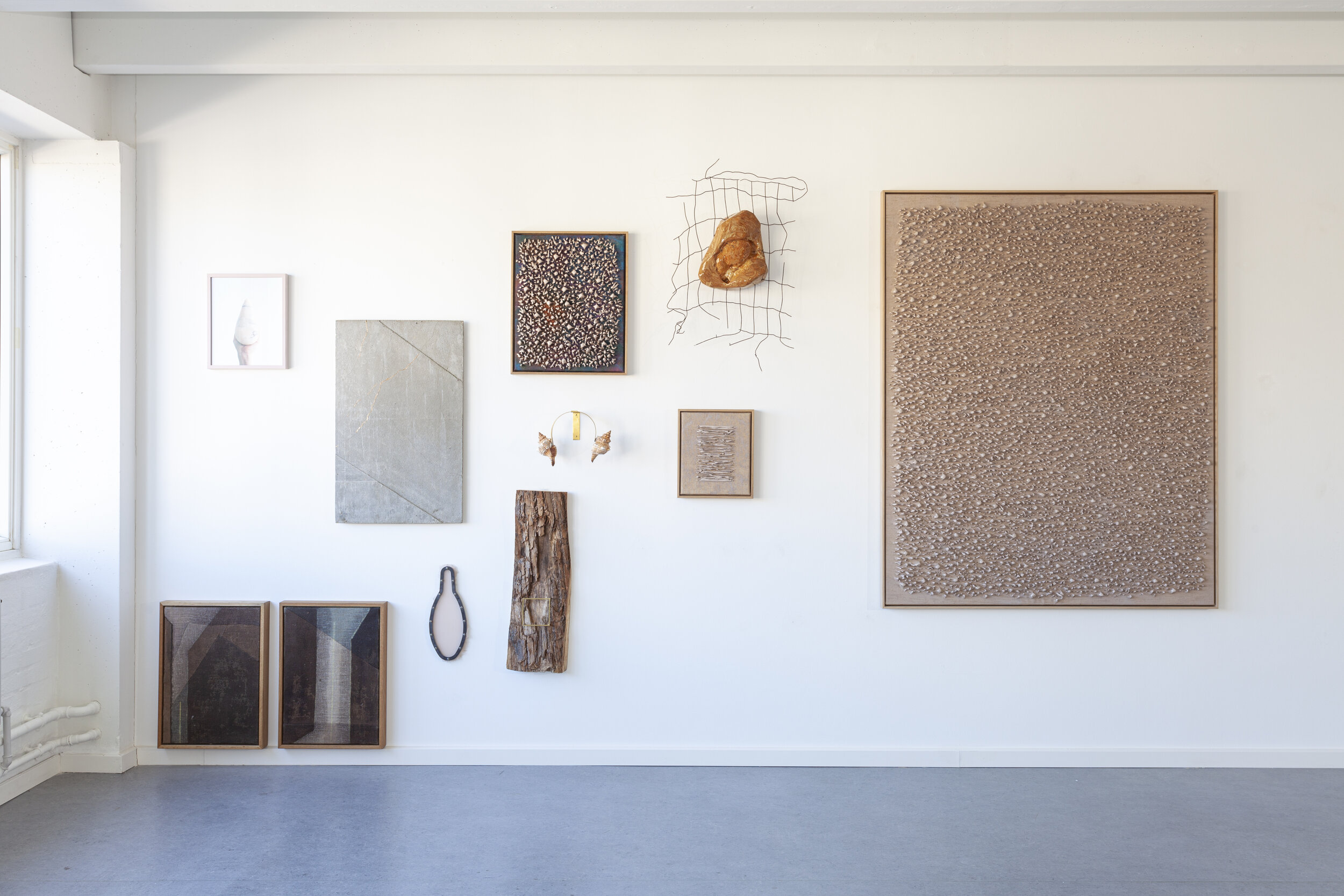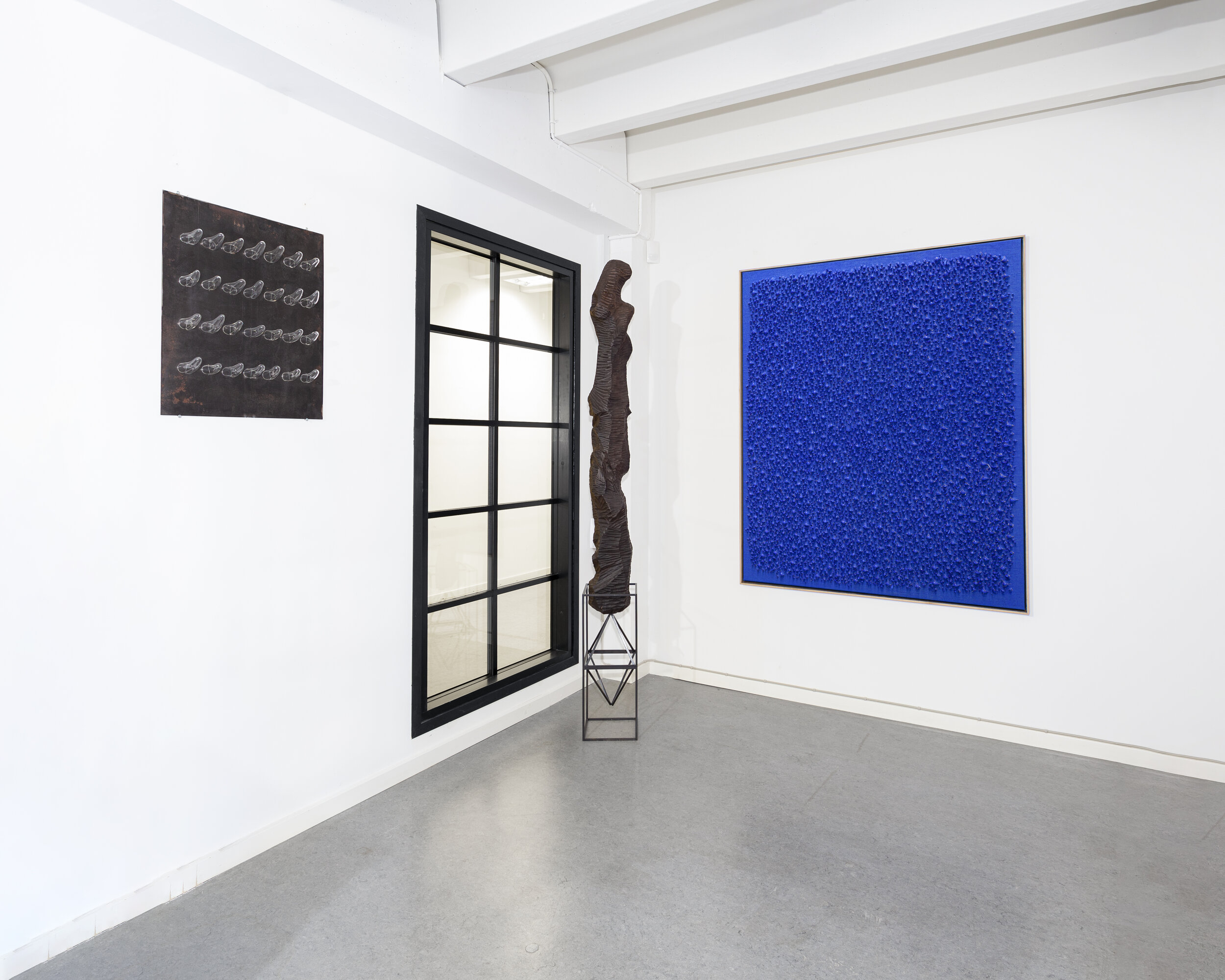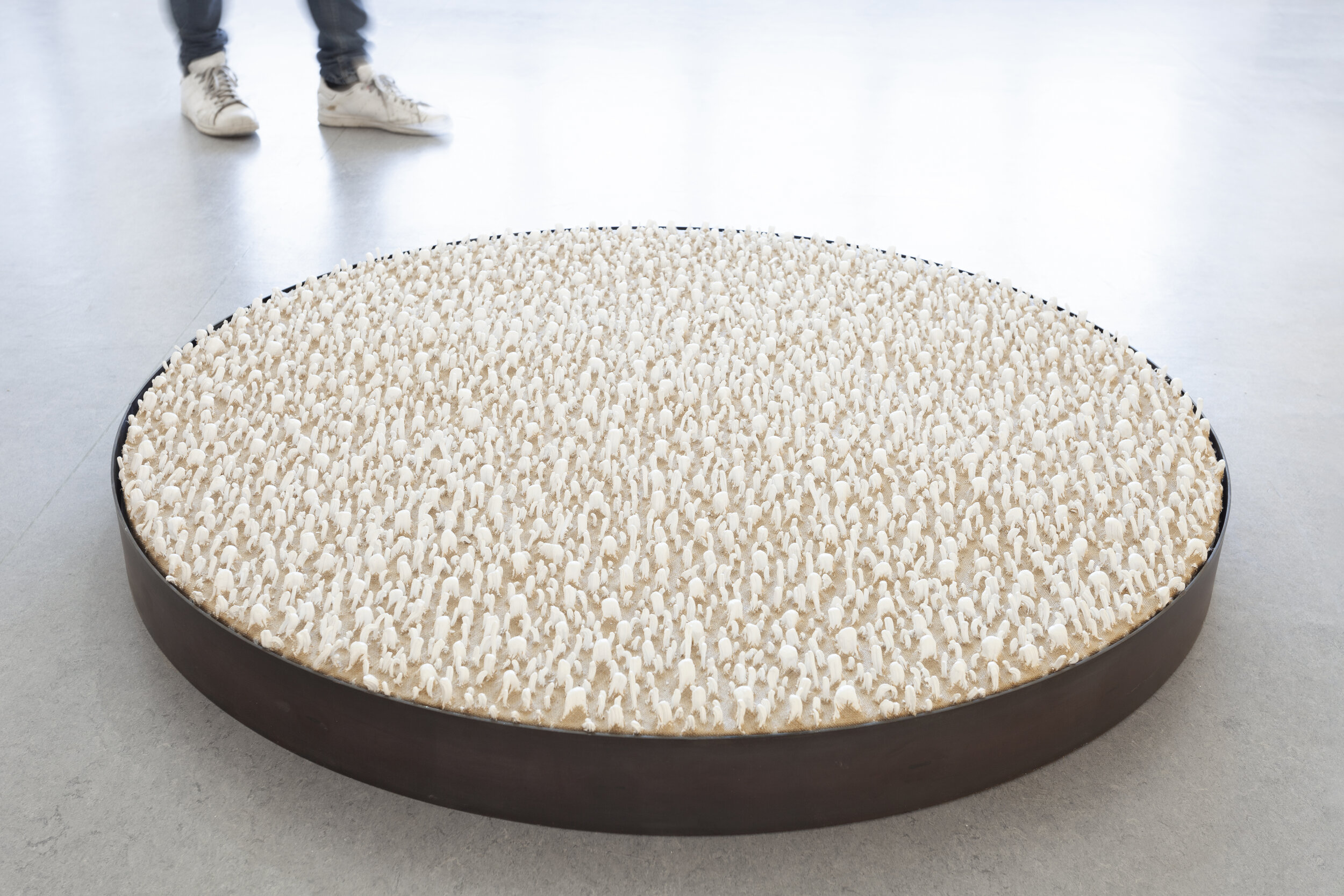SHIVER
LEA GULDDITTE HESTELUND
MAY 3 - JUNE 22, 2024
OPENING FRIDAY, MAY 3, 2024, 16 – 19
Lea Guldditte Hestelund’s new exhibition, Shiver, is a story of the transformation of a body – and of bodies in transformation. From a critical reconstruction of the ideal male body to portraits of the mother’s body in all its vulnerable monstrosity, the exhibition brings together themes and materials spanning Lea Guldditte Hestelund’s entire practice.
Shiver is Hestelund’s first solo exhibition solely with photographic works. The works are made over the span of 10 years and display her continuous and determined examination of the body as a cultural zone of conflict.
Excerpt from exhibition text by Nanna Stjernholm Jepsen.
LANDLINES / LINHAS FIXAS
Andreas Albrectsen (DK/BR), Anna Bella Geiger (BR), Tamar Guimarães (BR) and Kasper Akhøj (DK), Renata Lucas (BR)
Otavio Schipper (BR), and Carla Zaccagnini (BR/AR)
Curated by Andreas Albrectsen and Laura Goldschmidt
March 15 — April 27, 2024
LINK TO FULL EXHIBITION PORTFOLIO
Photos by Kevin Malcolm
LANDLINES / LINHAS FIXAS
Landline is a compound word that forms a drawing in one’s mind. It is a horizontal contour that cuts through space, defining the ground and the above. Drawing a line is simple enough, but to spatially define a void is an abstract thought. One needs to reinvent physics symbolically. A crudely drawn connection between two points is all it takes to make a horizon, to give the emptiness direction – a future and a past. Where a line can be a communication tool between existing and alternative worlds, this exhibition connects a long-distance call between physical, social, and spiritual structures. The artists’ works touch on various themes, such as urbanisation, displacement, memories of technology and its social and esoteric relations.
The exhibition title refers to the undersea internet cables that carry data across the Atlantic Ocean, connecting the South American and European continents. The transmitted data, a non-linear stream of human interrelations, travels deep below international waters and beyond our awareness. Approximately seventyone percent of the surface of the Earth consists of oceans, yet humans have only explored a fraction of the oceanic floor. Scientists have investigated far greater percentages of planet Mars than the seabeds on Earth [1]. Our internet infrastructure – the arteries of modern globalisation – lies in absolute darkness.
On the initiative of Dom Pedro II, the last monarch of Brazil, the first telegraphic submarine cable arrived by boat at Copacabana beach in 1873. The new era of long-distance communication also coincided with the rise of the spiritualist beliefs of the late nineteenth century, which was rooted in the mediumship between the material and spiritual plane. In Brazil, the followers of Allan Kardec’s spiritist doctrine became widely popular and spread across the country. The telegraph cable’s ability to transmit messages across the Atlantic was a wonder of the Second Industrial Revolution. But the uncharted potential of the technology was simultaneously associated with a paranormal potential – as a landline to the otherworldly. “The invisibility and intangibility of electric current, and its capacity to collapse time and space into a single, continuous plane of reference, provided the perfect analogy for the existence of the human soul beyond the body. After all, if telegraphic technologies could harness electromagnetic forces in order to communicate intentional messages, why should it not be possible to develop comparable techniques in order to communicate with the dead?”[2]
From ancient history until the Renaissance, the Atlantic Ocean was seen as a mythological void in the West. It was known as the frontiers of the world, the sea of darkness, and the passageway between the old and the so-called New World. The term Atlantic derives from ‘The sea of Atlas’ – after the Greek mythological Titan who holds the heavens on his shoulders. The imaginary lost continent of Atlantis was described as ‘the Island of Atlas’ by Plato in Timaeus and Critias. The speculations of an undiscovered civilisation continued to resurface throughout the early colonial age when Europeans identified Atlantis as the Americas.
To this day, fantasies of a submerged continent keep the myth of Atlantis afloat in online news media. With high-speed connection comes the risk of over-information, and our cognitive sense of urgency and factuality adapts. Atlantis-2 was the name of the first submarine fibre-optic cable system to connect Brazil and Europe with internet. It launched in February 2000 and was disconnected again in January 2022 when substituted by the superior EllaLink cable. But where its name may have been a metaphor for the internet utopia of the early 2000s, it is now a fitting metaphor for the looming eco-collapse that the world faces. Though the 8,500- kilometre-long cable is currently in the process of being retrieved, many others of the 500+ privately owned cables are prone to remain buried in the ocean as infrastructural ruins of human civilisation.
// Andreas Albrectsen
[1] ‘Why we have better maps of Mars than of the seafloor – and what USGS is doing to change that’, 17 November 2023,
https://www.usgs.gov/news/science-snippet/why-we-have-better-maps-mars-seafloor-and-what-usgs-doing-change
[2] Jeremy Stolow, ‘Wired Religion: Spiritualism and Telegraphic Globalization in the Nineteenth Century’, in Empires and Autonomy: Moments in the
History of Globalization, eds. Stephen Streeter, John Weaver, and William Coleman (Vancouver: University of British Columbia Press, 2019), p.89.
ABSTRACT SENSIBILITY
Ruth Campau (DK), Lars Christensen (DK), Imi Knoebel (DE), Malene Landgreen (DK),
Landon Metz (US), Tove Storch (DK) and Charlotte Thrane (DK)
CURATED BY LARS CHRISTENSEN IN COLLABORATION WITH CAROLINE BØGE
JANUARY 18 - MARCH 9, 2024
Photos by Kevin Malcolm
Rhythmic repetitions, serial formal languages, spirituality, pure perception, the physical appearance of color, transcendence, examinations of form in time andform in space, color as communication, minimalism, traces, decoding, and works as bodies. All of this is at play in this space.
When reading about abstract art, you come to know abstraction also as a portal to new realms of consciousness, ranging from mysticism and spirituality, to formalinvestigations on systems and questions about the significance of work components. According to the French philosopher Jacques-François Lyotard, we may evenencounter the sublime in these unexpected art encounters, where we are torn between what is depicted and what we can comprehend. These realms ofconsciousness and the movement between them require a sensibility, an emotional awareness that opens up new meanings and paths into an artwork that we hadnot previously thought possible.
When the subject is removed, we are forced to find replacement motifs, anchors. It can be form, color, or perhaps composition and material. The artist’sconscious use of color becomes a crucial marker here for our position in relation to the work as a phenomenon, the work as a body. Our awareness sharpens. Ourpersonal interpretation is colored and formed. But is it the colors that reveal the bodies and meanings of the works, or is it the form that creates the appearance ofcolors?
These new encounters with works make color as a marker in the abstract spectrum debatable. Color expands the pictorial surface and emphasizes sculpturalqualities. It allows us to experience the full freedom of abstraction. But just like abstraction, color is vulnerable. Neither color nor the abstract work is anythingwithout definition or context. If the artist does not provide us with a purpose, we create our own. Regardless of what the artist may think. The ultimate fact thatmakes abstract art eternally valid. Abstract art allows us to ask banal questions about the relationship between form and color – linger and realize that there isactually nothing banal about that relationship at all. Abstract Sensibility isolates and identifies the fundamental characteristics in the works, which define them.Form and color. Period.
Text by art historian Camilla Mosekjær Christensen
CHRISTMAS SALON
LARS CHRISTENSEN, SOPHIE DUPONT, JEANNETTE EHLERS, GUN GORDILLO, LEA GULDDITTE HESTELUND,
MALENE LANDGREEN, KIRSTINE ROEPSTORFF AND DAN STOCKHOLM
DECEMBER 7, 2023 - JANUARY 10, 2024
EARTH SCHOOL - CLASSROOM NO. 1
KIRSTINE ROEPSTORFF
OCTOBER 13 - DECEMBER 2, 2023
Installation views by VSTR20
Look into the mosaic eye
Light bends into itself, images fold and twist, representational reality flows like water.
Peeping, searching, scrying we look for answers to the everyday and the existential in technology, algorithms, data: oracles of another color, different bottle same wine.
Divination is a lost science and yet we use it daily without knowing or wishing to acknowledge how much we revert to the intuitive impulse to ‘see’.
The most enlightened condition of ‘not-knowingness’ has now somehow become a feared state in our time of sectarian absolutes.
We are only using the forced flip of a coin to ‘pick a side’.
How quick we divide into groups, stereotypes, tribes. And yet it is the ability to trust the sound of the wind, feel the patterns of the fish in the sea or the birds in the sky, and establish alternative trusts in the pseudoscientific kaleidoscopic patterns that will truly reveal the flows of humanity.
It is a new school we are wishing for.
A school that allows us to better let go of the black and the white and feel our steps float along the path. It is in the Greek understanding of these energies, in the Platonic realm of this divine breath known as ‘pneuma’ that we can emancipate our energetic impulses into a better place for understanding and accepting the unknown.
What can my fear teach me?
Look at it in the face that emerges from the clouds, from the gossamer of smoke, from the twisting vortex that defies our concrete reflexes of knowledge.
Here we arrive at the new school that has been teaching us the path since time immortal.
You can feel it the moment you stop trying to feel it.
Everything flows.
Let go and you can feel it.
It is to understand that you are the path and not defined by it that allows you to become water.
Look into the mosaic eye to ‘see’.
Text by curator and anthropologist Aaron Moulton
reflexion
GUN GORDILLO
AUGUST 18 - SEPTEMBER 30 2023
GUN GORDILLO is the magician of neon. She has been creating works from this luminous material – which fascinates with its colourful yet immaterial nature – for nearly 50 years. Having seen the light, so to speak, on a trip to Cairo in 1974, she was enthralled by the electric aura of the city’s ubiquitous neon advertisements.
Gordillo has been making reliefs combining neon, metal and painted wood ever since, in a spirit that derives from geometric abstraction but does not exclude recourse to natural elements like wax, feathers or bamboo. In the 1980s, when her career was taking off between Denmark, her native Sweden and France (where she has been represented by Galerie Denise René since 1985), Gordillo’s approach to neon evolved towards a spare, minimalistic plastic vocabulary, both in her reliefs and in installations. These works, obtained in the context of major private and public commissions, were set both in nature and in relationship to architecture, and involved a poetic reflection on space and the environment.
The works assembled for Gun Gordillo’s solo show at 2112, her first with the Copenhagen gallery, offer a delightful overview of her talent and her ability to renew neon’s expressive potential. In reliefs like Nouyi, where light is fully integrated into the support, the forms painted with broad gestures on the surface create circular, halo-like rhythms, transforming the work into a luminescent, vibrating space. The neon light, gently filtered by the translucent surface masking it, is modulated in tones that reflect Gordillo’s attention to white – treated in warm, cold or bluish tones. These different radiating sources evoke, in turn, a hazy moon, a distant sun, moving shadows, shimmering surfaces or ethereal, gaseous elements that constitute sources of the artist’s inspiration
In reliefs like Circulos Bleu, the bare neon enlivens the work’s surface with slanting or swirling outlines that resemble the script of some unknown language. In recent works such as Luce e Ombra, Gordillo traces the neon’s outlines in pencil on a white surface; the sinuous, biomorphic outlines evoke nature and have an organic feel. Gordillo also likes to exploit neon in its simplest form, suspended mid-air to restore its expressive freedom. Works like Absence Présence, show how skilfully she exploits neon, handling it like malleable matter falling under its own weight.
Her neons, which seem drawn in empty space, have a subtle impact and never strive for effect. In fact, rather than showing her works spectacularly in the dark, Gordillo prefers them to be seen in daylight or half-light, so they can exploit variations in natural light and alter with each passing hour to create a pensive, cosmic or electric ambiance. She often has recourse to offbeat presentation – hanging her light sculptures from wall-bars or high up in corners, as if to take visitors by surprise.
Lately, Gordillo has enjoyed experimenting with new scenarios, combining neons with small, circular mirrors (in BLUE) and accompanying their curved outlines with smoothly articulated steel or copper wire. Gordillo’s skilled understanding of materials is no constraint, but accompanied by tremendous inventive freedom that means her plastic vocabulary is ceaselessly renewed.
Her works become a force field activated by the contrasting use of luminous and opaque materials, hard or soft surfaces, and straight lines or curves. Electric light encounters metal and mirror, while colour is suspended as if by levitation. Space is no longer implied, but revealed and captured: depending on the angle of view, the plays of luminous reflection offer viewers a multifaceted vision in which their own space and that of art blend into one another.
In her sensitive and phenomenological approach to light, Gun Gordillo creates a dialogue between constructed and immaterial space. Her works are no mere objects of contemplation but visual events, where the viewer is caught up in neon’s hypnotic embrace and drawn into a ‘total experience.’
Text by Domitille d’Orgeval
Domitille d’Orgeval
Doctor in art history, art critic and independent exhibition curator, Domitille d'Orgeval specializes in the history of geometricand kinetic abstraction, as well as in the relationship between art and architecture. She has participated in several reference works on geometric and kinetic abstraction, notably on Mehdi Moutashar, Marcelle Cahn, Pascal Haudressy, Vasarely, Kupka, Julio Le Parc, Sonia Delaunay, Herbin, Geneviève Claisse, François Morellet and Vantongerloo, several exhibitions including Topographies of Light, Immaterialities (Espace Topographie de l'art, Paris, 2021, 2017), Horizons (Franklin Azzi Architecture Endowment Fund, Paris, 2021), Elias Crespin (Maison de l'Amérique Latine, Paris, 2017) and DYNAMO. A century of light and movement in art. 1913-2013 (co-curator, National Galleries of the Grand Palais, Paris, 2013).
EI BLOT TIL LYST
LARS CHRISTENSEN, SOPHIE DUPONT, JEANNETTE EHLERS, GUN GORDILLO,
LEA GULDDITTE HESTELUND, MALENE LANDGREEN, KIRSTINE ROEPSTORFF AND DAN STOCKHOLM
JUNE 2 - AUGUST 10, 2023
EI BLOT TIL LYST is written above the old stage of the Royal Danish Theatre. The phrase was placed in 1774 and serves as a subtle reminder of the theatre’s moral and educational role in society. EI BLOT TIL LYST meaning “not just for pleasure” or “not only for entertainment” also reflects the theater’s position in providing cultural and societal significance and enlightenment. It is a statement that hits close to home for 2112’s founder Caroline Bøge, who as an art historian and former ballet dancer is a strong believer in the transformative power of the arts.
The exhibition presents works by all represented artists and marks the inaugural opening of our new venue in Holbergsgade 20.
For this exhibition Lars Christensen has created a site-specific installation consisting of two brightly yellow ‘Color Poles’ that shape shift between sculpture, painting and architectural intervention. The works are created through a bodily action of piercing the canvas before mending it by pushing acrylic paint through from the back side leaving it up to chance and gravity to create the final form.
Sophie Dupont’s diptychs from her recent ‘One Breath’ series are a continuation of the artist’s ongoing investigations into the act of breathing. Throughout the past decade the artist has regularly carried out her ‘Marking Breath’ performance in which she traces her breath from sunrise to sunset. In this new body of work, Dupont focus on the single breath by removing and transferring oil paint from one metal plate to another during one breath.
In Jeannette Ehlers’ photographic stills from her video work ‘Black Magic at the White House’, the artist appears as a ghost like figure performing a vodou dance inside a Danish colonial building. Rendered digitally almost invisible, her body is seen as the outline of a blurred void moving through the ornate living rooms in the mansion. In the presence of her absence, Ehlers brings attention to Denmark’s participation in the Transatlantic Slave Trade that have all too often been rendered forgettable by dominant history-writing.
Suspended from the ceiling is the curled pink neon work ‘GREMBO’ by Gun Gordillo, who also presents the three-dimensional wall-based work ‘in REFLEXTION’. Since the 70s, Gordillo has worked with neon as her primary medium, and she is today considered a pioneer within her field. Gordillo’s artistic practice can be viewed as an ongoing investigation of her chosen materials. She often places neon lights in dialogue with lead, steel, brass, wood, acrylic glass, paint etc., and works to the very limits of the possible. With her non compromise attitude to art and life, Gordillo’s works become testaments to the sublimely beautiful, the poetic and the rebellious.
In one of the windows Lea Guldditte Hestelund’s ‘S.B.H.P. (safety balaclava head protection) S.B.H.S. (safety balaclava head support)’ is on display. On a modified clothing rack by Verner Panton, Hestelund has placed two balaclavas in soft cotton that act as protective shelters for mothers and other bodies in need of a soft buffer. The work was created for the artist’s recent solo exhibition titled ‘Hissy Fit’ at Politikens Forhal that created a space for the non-romanticized aspects of motherhood. Also on display is a new photograph ‘self portrait w/p.rose’ in which the artist’s body is lying closely to her own sculptures – almost melting into them and blurring the border between flesh and stone as well as the artist and her work.
Malene Landgreen’s two colorful paintings ‘Memory Card’ bear witness to the artist’s distinctive color palette and ongoing work with shapes, lines and patterns carefully put together in compositions of color relationships that often have geometry as their starting point. Typical for Landgreen are her instantaneous gestures of lyrical, organic and material expressions intervening with the concrete composition. In the two playful ‘Memory Card’ paintings, Landgreen flirts with figuration by placing elements of the body as floating limbs in a grid of colors which underscores her virtuosity as a painter and artist.
The new large-scale diptych ‘New Born’ by Kirstine Roepstorff is part of the artist’s new ‘Meditation – Parallel Time’ series that can be seen as a continuation of her ‘watering paintings’ in which layered water colors on rough, untreated canvas resembled pigment sediments left by water. In this new body of work white circles, squares, and lines appear and create a feeling of looking into another dimension though a digital lens. A key aspect of Roepstorff’s practice resides in her continual probing of the boundaries separating our inner and outer worlds, as well as her deep fascination with the spiritual and metaphysical dimensions of life. Roepstorff creates works that equally appeal to our deep aesthetic senses as well as our social and existential awareness.
‘By Hand’ is one of several pieces by Dan Stockholm that explores the process of making an object by capturing its performative actions within the work. The imprint of the hands mimics gestures Stockholm made during a 2013 performance in which he touched every inch of his father’s house after his death. The intimate moments now embody their own structure, the abstract shape of his father’s home reincarnated through gesture. Also on display is a new ‘Bedrock’ work in which the artist inserts strong sleeping pills into slabs of different kind of granite. In this specific ‘Bedrock’, a composition of small white Zopiclon sandoz 7,5 mg pills are engraved into black tempest quartzite mimicking a starry night sky.
SOPHIE DUPONT
REST WITH Me
FEBRUARY 2 - MARCH 24, 2023
The works in the exhibition are ‘Imprints of Sleep from Tlalpan’, 20 km south of Mexico City November 21-25, 2022. The colors are inspired from The Chapel of Luis Barragan which is located just around the place El Sur Residency where Sophie Dupont worked for two months in the end of last year. Two of the imprints are made during the performance ‘Rest With Me’. The colors are a mix of the colors used in the ‘Imprint of Sleep’.
“Inside inside
outside outside
We are together
We care
In time in space
We breathe
We plant
We cry drops
We drop
We drop down
Into drop water
Tears of flow
Flow of water
Flow of air
Of freedom to come
We plant the soil
With love and joy
Hate despair
It all comes together
Connecting
Connecting
In what we call life
Inside inside
Outside outside
How do we plant
What we call love?
I am a flower
I am a tree
I am the darkest
Polluted air
I say I am human
Do u trust me?
Do you trust my fragility?
I care for you
Could u love me
If I love you?
For this time now
I ask of you
To join me horizontal
Come resting with me
We do what we do
When we do nothing
Fragile and vulnerable
It is my favorite thing to do.”
GUN GORDILLO
THREE SCULPTURES
OCTOBER 10 - NOVEMBER 11, 2022
The exhibition includes the three light sculptures ‘FAA I, FAA II & FAA III’, Gun Gordillo created in Faaborg while participating in the third season of the DR tv-program ‘Kunstnerkolonien’.
For more than 40 years, Gun Gordillo has worked with neon lights, often in combination with lead, stone and metal and frequently with the addition of acrylic sheets or mirrors as a means of creating spatial effects. Her works thus give rise to a dialogue between gravity and lightness. Gordillo’s work has been shown at several major solo exhibitions. Since the 1980s, she has worked with legendary gallerist Denise René and has participated in many group exhibitions including ‘The spirit of white’ at Galerie Beyeler, Basel (2004), and ‘Néon’, who´s afraid of red, yellow and blue?" at La Maison Rouge, Paris (2012). She has also been invited to create several major installations at world famous companies and public sites in cities such as Basel, Paris, Copenhagen and Stockholm. Gordillo lives and works in Copenhagen after having spent many years living and working in Paris.
KIRSTINE ROEPSTORFF & DAN STOCKHOLM
NEW WORKS
MAY 19 - JUNE 15, 2022
MALENE LANDGREEN
NEW WORKS
APRIL 24 - MAY 6, 2022
SOPHIE DUPONT
Imprint of Sleep, Paris, Monday to Sunday NOVEMBER 8-15, 2021
FEBRUARY 24 - MARCH 19, 2022
Sleep is a fluid state that differs from the awake consciousness. It is a kind of magical state, in which our dreams allow us to process the day passed and set it in relation to memories, impressions, perceptions, states of mind, etc. In her 'Imprint of Sleep' series, Sophie Dupont explores ways of transferring the magical state of sleep on to the canvas. Placed horizontally on the floor, the canvas, measuring twice the size of the artist's own body, is applied with paint and pigment on one half, after which it is folded. Finally, the artist sleeps one night on top of the folded fabric.
Thus, affected by the body's pressure and movements during the night, the top of the canvas takes imprint from the color on the bottom. As the canvas is unfolded in the morning, an almost symmetrical picture emerges - a kind of topographical map, or bodily landscape painting of the unknown land of sleep. Dupont's works are created effortlessly in her sleep, as her uncontrolled body movements determine the final result. Through her studies of the body and consciousness in the state of sleep, Dupont implicitly comments on a society that places ever higher demands on efficiency, including reduction of sleep, and where insomnia and memory loss as a result is a growing problem.
The seven presented works represent a week’s sleep and were created in Paris during the nights November 8 - 15, 2021.
LARS CHRISTENSEN
NEW OBJECTS
NOVEMBER 17 - FEBRUARY 2022
THE COLLECTOR (text in Danish only)
Han søger, jagter og sporer små og store fragmenter, der er kastet over området som vragstykker fra et moderobjekt. Nogle af fragmenterne kan han bære med sine hænder. Andre må han bruge dage på at få flyttet tilbage. De er svære at skjule for de andre, der er på jagt. Disse objekter. Kuberne. De hører sammen. Han samler dem. Han kan mærke deres forbindelse som en elektricitet, der sitrer i luften, når han kommer tæt på.
-
Deres bestanddele af sort jern, der tungt og køligt med en glat overflade, holder sammen på den kraft, der lader massen trænge igennem objekternes membran. Gennem fibre og huller presser en signalfarvet plastisk masse sig ud. Han ved endnu ikke, om massen holder sammen på objektet eller frastøder de metalliske rammer, der holder det. Men objekterne lever, føder, formerer, vækster. En antropocæn hybrid mellem organisme og mekanik. Objekter født ud af den plastiske dystopi, der har taget magten - efterladt jorden gold, kun for at kunne skabe en verden af geometri, akryl og jern. Som ruiner fra en oldtidsby eller vragdele fra et flystyrt, både maskeres og afsløres objekterne af det landskab, de er blevet smidt i.
-
Ingen kan rigtig huske, hvordan naturen så ud dengang. Hvordan vandhuller og jordbund skabte liv. Han vidste, at måske ikke fremtiden, men en form for tid, måtte findes i dens farvede masse, der som små tentakler, vokser ud af objekterne - siver, søger, som en svampevækst vidner den om et potentiale. Jo mere objekterne sættes sammen, des mere aktiveres de. Han samler for at finde svar om denne efterverdens transformation.
Af Camilla Mosekjær Christensen
2112 CHRISTMAS SALON 2021
Works by Malene Landgreen, Sophie Dupont, Kirstine Roepstorff, Lea Guldditte Hestelund,
Dan Stockholm, Lars Christensen and Studio ThinkingHand
Curated and installed by Sven Dumelier
DECEMBER 2021
STUDIO THINKINGHAND
Solo Presentation
AUGUST 13, 2021
2112 x VON BARTHA
The Imaginary Collection: Take the Stage
Anna Dickinson, Barry Flanagan, Athene Galiciadis, Terry Haggerty, Imi Knoebel, Mike Meiré, Landon Metz,
John Wood & Paul Harrison, Sarah Oppenheimer, Francisco Sierra and Claudia Wieser
Curated by Caroline Bøge in collaboration with von Bartha
Lars Christensen
NEW WORKS
MARCH 17 - APRIL 8, 2021
2112 CHRISTMAS SALON 2020
New smaller works by Kirstine Roepstorff, Malene Landgreen, Lea Guldditte Hestelund,
Sophie Dupont, Mille Kalsmose, Lars Christensen and Dan Stockholm
CRUDE: New works by Kirstine Roepstorff
After a period of extensive exhibition activity including her solo shows at the Danish Pavillon for the Venice Biennial (2017), Kunsthalle Charlottenborg and Trapholt (2018), and Kunsthaus Zürich (2019), Roepstorff has dedicated her time to the studio out of which a new body of work has emerged. The presentation has been made in collaboration with curator Diana Baldon, who has also written an accompanying text (please see below). Baldon is former executive and artistic director of institutions such as Index - the Swedish Contemporary Art Foundation, Malmö Konsthall and Fondazione Modena Arti Visive.
Introduction by Diana Baldon
Wavering between geometric abstraction and informal organicism, the unforced and harmonious arrangements of Roepstorff´s paintings, sculptures and spatial installations have made her internationally known. Her abstract visual vocabulary visualizes patterns that either form the individual and collective self or have shaped the history and failures of utopian 20th Western ideologies and their belief systems.
Roepstorff´s new body of works is crude. Some show their double side, with reverse silhouettes that avoid facing the viewer´s gaze. The rawness and organicism of most canvases strip pictures naked to the skin, bearing traces of emerging and indistinct sensations in search of an identity. The fluid and improvisatory effects of shapes and colours resist to rest on a set form, sheltered within an infinite process of gestation. Sitting between development and conclusion, course of action and termination, they allegorize how today we collectively navigate through a world of dissolving structures (i.e. the current pandemic) that affect us and demand a radical calibration of our emotional compass as well as of our actions directed, more so than ever, at future generations.
Canvases incorporate a variety of fabrics whose stained and sewn surfaces, together with the muted tones and liquid mark-making, bring the viewer’s attention to how visual space can be tailored in the fashion human consciousness is. Their recurrent motifs are stains, seams and primordial eggs. The fluid and darkening effect of liquefied stains draw pictures with unstable contours, that recall biomorphic satellite images of the Earth's surface or shadows that threaten the world to transform it. They have an enveloping and pervasive character that evokes, to quote the French poet and novelist Louis Aragon (The Adventures of Telemachus, 1922), a space where the self begins to eclipse: night at high noon. The thin lines of colourless seams define separate spaces whose boundaries emphasize difference (dark/light, inside/outside), while the process of folding and unfolding cut-outs of refused artworks becomes trace of instability and indeterminacy. They also stand for metaphors of how we are constrained to constant shifts between opposites (visible/invisible, male/female, self/other, soul/world, material/imaginary, real/virtual).
The eggs are embryonic, cosmological pictures that, such as pregnant lifeforms in the likes of spheres or globes, are to give birth to a crowd of images that aspire to be born. Two of them are encased within protuberant frames of sombre wood, adorned by handmade mosaic tiles. They can be perceived as icons of the spectacle of the uterus aimed at grabbing an undefined and yet clearly arising future originated by means of individual and collective decisions that take place now. Roepstorff defines this condition as “seeds”, evoked by a series of abstract ceramic sculptures that precariously sit on hollow plinths. The introduction of clay and of manual labour, a key characteristic of applied arts techniques, responds to the highly and rapid technological aesthetics resulting from today´s globalised processes. But is also establishes a dialogue between high art and craft’s humble aesthetics, a tactile practice where manual manipulation and the malleability of surfaces illustrate how reality can be transformed. The artist’s need to wrestle with the material to create cavernous and curved orifices reveals how her rough and yet sensuous touch is expression of a magical blend between erased memories and unripe actions.
Copenhagen, July 2020
